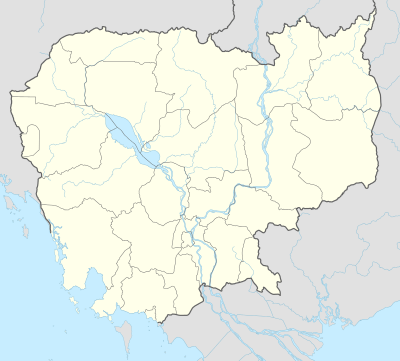O Smach
| O Smach អូរស្មាច់ | |
|---|---|
| City | |
 O Smach Location of O Smach, Cambodia | |
| Coordinates: 14°24′36″N 103°41′39″E / 14.41000°N 103.69417°E | |
| Country |
|
| Province | Oddar Meanchey Province |
| District | Samraong District |
| Government | |
| • Type | City |
| Time zone | Cambodia (UTC+7) |
O Smach (also O'Smach or Ou Smach, Khmer: អូរស្មាច់) is a small Cambodian town on the Thai border in the Samraong District of Oddar Meanchey Province. Until 1999, there were intermittent battles and the area was unsafe as the last remaining Khmer Rouge still had control of nearby Anlong Veng. In 2003 an international border crossing was opened between O Smach and the adjacent town of Chong Chom in Thailand's Surin Province. There has since opened a strip of casinos between the Cambodian and Thai passport control counters, enabling Thais to gamble in Cambodia without needing to go through Cambodian immigration. Gambling is illegal in Thailand and gambling in Cambodia is legal only for foreign passport holders. O Smach is located at the northern terminus of Road 68 which turns north off National Highway 6 at Kravanh in Siem Reap Province.[1]
Border crossing
Most of Cambodia's northern border with Thailand is formed by the escarpment of the Dangrek mountain range. A natural pass cuts through the mountains between O Smach and Chong Chom. This pass has been used since ancient times to travel between the plains of lower Cambodia and the Khorat Plateau. Beginning with the Cambodian Civil War and lasting until the surrender of the last remaining Khmer Rouge who had taken refuge in Anlong Veng, the Khmer Rouge controlled the area and generated income by illegally trading Cambodian timber across the border in Thailand. After the final surrender of the Khmer Rouge in 1999, the region surrounding the O Smach pass once again became stable and safe for travelers and, in 2003, the Cambodian and Thai governments opened an international border crossing. The border crossing suffered intermittent closures again between 2008 and 2011 during the Cambodian–Thai border dispute.[1]
The Thai government agreed to fund the extension of Cambodian National Road 68 from the provincial capital of Samraong to O Smach with an unspecified loan amount. Immediately, two casino hotels and a market were built in a strip between the two international passport control counters to cater to Thai nationals coming to Cambodia to gamble.[1] Gambling in Thailand is illegal but in Cambodia it is legal, although only for holders of foreign passports. This arrangement ensures Thai citizens can leave Thailand to gamble in O Smach and then return home without having to pass through Cambodian immigration.[2] Thais living close to Chong Chom are responsible for the bulk of cross border activities. The O Smach border crossing is the least used among the Thai/Cambodian checkpoints. Most tourists en route to Siem Reap, where Angkor Wat is located, cross the border at Poipet which is also the more popular gambling destination due to the relative ease of access from Bangkok.[1][3]
O Smach benefits more from international trade. As of 2012, O Smach and its Thai counterpart, Chong Chom, had all the necessary customs facilities except for an agricultural quarantine officer. The main product exported from Cambodia through O Smach is cassava. There is also a large market for second-hand bicycles which are imported to Cambodia from Japan, taken to O Smach and sold across the border to Thais at the Chong Chom market. The primary imports at O Smach is used farm equipment, mostly tractors and trucks. Construction materials and petroleum products are also imported to Cambodia through O Smach.[1]
Future development
As of 2015, the only vehicle crossing between Cambodia and Thailand is at Poipet. Vehicles other than those given special permission by their respective central government are not allowed to cross the border at O Smach. However, starting in 2015, a Cambodian company began running a direct bus route from Siem Reap to O Smach. The 2.5 hour 160 km trip costs passengers USD 12.50 and caters to "hospital tourists", Cambodians who are heading to the Thai town of Surin, where the Northern Khmer dialect is commonly spoken, for more trustworthy medical treatment.[4] After producing passports or border passes and paying 10,000 riels (USD 2.50), they cross the border on foot and board a Thai minivan that shuttles passengers on the final leg of the trip, a 45-minute stretch from O Smach to Surin for an additional 80 Baht (USD .50).[4] Also in 2015, at a trade meeting in Siem Reap, Thai and Cambodian officials and entrepreneurs agreed to invest in an air-conditioned bus service between Thailand and Siem Reap through O Smach. The service was expected to begin before the Surin Elephant Round-up and facilitate Cambodian visitors to the annual event.[5]
References
- 1 2 3 4 5 Hatsukano, Naomi (2012). Ishida, Masami, ed. "Will the Emerald Triangle Development Cooperation Be Reactivated? : The Silent Cooperation Scheme between Cambodia, Lao PDR and Thailand" (PDF). BRC Research Report. Five Triangle Areas in The Greater Mekong Subregion. Bangkok, Thailand: Bangkok Research Center, IDE-JETRO. 11. Retrieved 10 November 2015.
- ↑ "Casinos in Cambodia: When the luck runs out". The Economist. 23 October 2014. Retrieved 10 November 2015.
- ↑ Chan, Muyhong (3 March 2015). "New border crossing set to make trade easier". The Phnom Penh Post. Retrieved 10 November 2015.
- 1 2 Ritz, Naomi-Collett (22 September 2015). "Thai Hospitals Making Inroads". Khmer Times. Retrieved 10 November 2015.
- ↑ "Thai and Cambodian traders sign tens of business deals, worth nearly THB2,000m.". National News Bureau of Thailand. 27 June 2015. Retrieved 10 November 2015.
Coordinates: 14°24′36″N 103°41′39″E / 14.41000°N 103.69417°E
